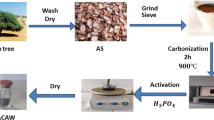Abstract
The effectiveness of processed solid residue from olive-mill waste (JEFT) and solid residue of pyrolyzed oil shale in removing methylene blue as a cationic dye and methyl orange as an anionic dye from aqueous solutions has been investigated and compared with that of a commercial activated carbon, namely coconut-shell carbon. All three sorbents showed significant methylene-blue removal, but only the coconut granular-activated carbon showed notable methyl-orange removal. The oil-shale sorbent showed no removal and the olive carbon showed poor removal of methyl orange. The removal of both methylene blue and methyl orange increases with the lapse of time, and attains equilibrium in 100 min.
Similar content being viewed by others
Author information
Authors and Affiliations
Additional information
Received: 12 May 1999 · Accepted: 1 November 1999
Rights and permissions
About this article
Cite this article
Abu-El-Sha'r, W., Gharaibeh, S. & Mahmoud, S. Removal of dyes from aqueous solutions using low-cost sorbents made of solid residues from olive-mill wastes (JEFT) and solid residues from refined Jordanian oil shale. Environmental Geology 39, 1090–1094 (2000). https://doi.org/10.1007/s002549900099
Issue Date:
DOI: https://doi.org/10.1007/s002549900099




